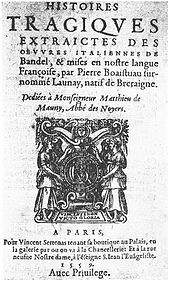Pierre Boaistuau
Pierre Boaistuau , also Pierre Launay (* around 1520 in Nantes , † 1566 in Paris ), was a French editor , writer and translator . He had a great influence on the literature of his time and subsequent generations. He was the first editor of a collection of short stories by Margarete von Angoulême that later became known under the title " Heptaméron " . His story "Rhomeo et Julietta" inspired William Shakespeare to write his famous tragedy " Romeo and Juliet ".
Life
The life path of Pierre Boaistuau is only partially known. He was probably born around 1520 (according to some sources even around 1500) in Nantes in Brittany , which had only belonged to the Kingdom of France since 1532. Presumably he studied law in Poitiers from 1543 and later medicine in Rome . In 1554 he went to Paris and temporarily entered the diplomatic service. In 1559/1560 he made a trip to England (supposedly to see monsters and miracles there), on which he is said to have had an audience with Queen Elizabeth . Boaistuau died in Paris in 1566.
plant
Boaistuau is considered to be the inventor of two characteristic genres of French literature of the 16th century, namely the "tragic story" ("histoire tragique") and the "extraordinary story" ("histoire prodigieuse"). His collection of short stories "Théâtre du Monde" ("Theater of the World"), published in 1558, was one of the most successful publications of its time.
In 1558 he was the first editor of a collection of stories by the French nobles and writer Margaret of Angoulême , Queen of Navarre (1492-1549). The collection later known as “ Heptaméron ” was published by Boaistuau under a different title (“Histoires des amans fortunez”). In addition, he only took on 67 of the original 72 stories and changed the frame plot significantly.
His collection of "tragic stories", published in 1559 under the title "Histoires tragiques", which were translations and adaptations of novellas by the Italian poet Matteo Bandello , also contained the story "Rhomeo et Julietta". It probably served as a template for William Shakespeare's famous tragedy " Romeo and Juliet " (in addition to the novel "The tragicall historye of Romeus and Juliet" by the English playwright Arthur Brooke ) .
In 1560 he published under the title “Histoires prodigieuse les plus memorables” a collection of “extraordinary stories” by ancient Greek and Latin authors that deal with mythical creatures and monsters of all kinds. He also distinguished himself as a translator of important ancient and contemporary authors (such as Erasmus von Rotterdam ).
Web links
| personal data | |
|---|---|
| SURNAME | Boaistuau, Pierre |
| ALTERNATIVE NAMES | Launay, Pierre |
| BRIEF DESCRIPTION | French editor, writer and translator |
| DATE OF BIRTH | around 1520 |
| PLACE OF BIRTH | Nantes |
| DATE OF DEATH | 1566 |
| Place of death | Paris |
